
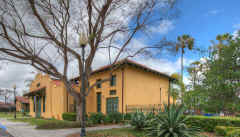
1930 Aerial View |
1995 - end of an era |
Museum |
Museum |
NRTF Chollas Heights (NPL) was the first Navy Global Radio Transmitting Facility. Construction of the three 600 foot towers supporting the VLF/LF antenna began in 1916. The site was built on 560 acres of land which was later reduced to 73.6 acres. The original transmitter was a 100 to 200 KW Poulsen arc machine. In 1917 when the transmitter first went on the air it was the most powerful in North America. As technology progressed MF and HF transmitters and antennas were added. On 7 December 1941 the transmitters at Radio Pearl were down for regular maintenance and during this period, Radio San Diego (NPL) was keying the broadcast via Radio San Francisco. Thus the first news of the Japanese attack on the fleet at pearl Harbor was broadcast by Radio San Diego. In the 1960s the site took on its final configuration with one LF transmitter and 23 HF and 6 UHF transmitters along with 32 HF and 6 UHF Antennas as well 11 Navy housing units.
In 1916 the cost of construction of one 600 foot LF tower was $33K. Seventy years later it cost $122K just to paint one. In September 1983 the site was transitioned to Civilian Contractor Operation and Maintenance under a Civil Service Director/Contract Administrator. As cost restraints and technology moved forwarded the number of LF/HF sites in the Navy Community had to be reduced. Chollas Heights came under the knife and all operations ceased on 30 September 1992. The 50 KW FRT-72A LF transmitter was silenced several months prior to closure to facilitate testing of the new generation FRT-95A. Demolition of the 600 foot towers took place on Veterans Day 1995.
The site is now home to 412 Navy housing units. The Transmitter Building remains and a part of it has been converted into a Museum with many items pertinent to the site's history and operation. Four of the original navy housing units as well as the top piece of one of the 600-foot towers remains on site. The Museum is open to the public at the present time during regular business hours on weekdays. Those wishing to visit the site can travel east on highway 94 to College Avenue, north to College Grove Drive, west to College Grove Way, and north to Transmitter Road. Pictures of the Site and Transmitters from the early days are available for viewing at the San Diego Historical Society.
For any additional information contact Paul Albanese (Director NRTF Chollas Heights 1983-1992) at E-mail address:
Lakepaul at aol.com.
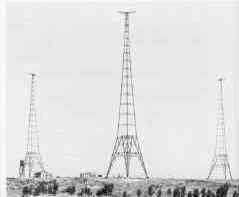 NPL San Diego - Chollas Heights - 1917 |
NPL Chollas Heights 1919
|
1926 Press Photo |
Joe Hallock atop
one of the 600' towers - 1916 |
Photos below from Historic American Engineering Record |
|||
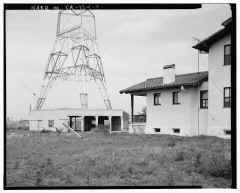
|
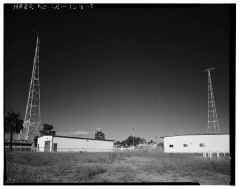
|
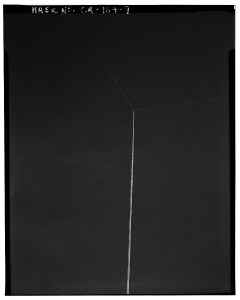
|
 |
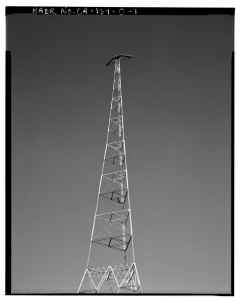
|
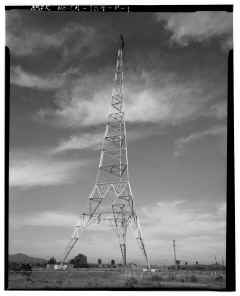
|
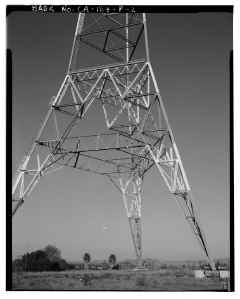
|
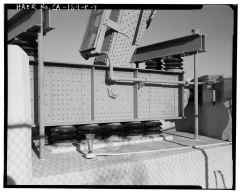 |
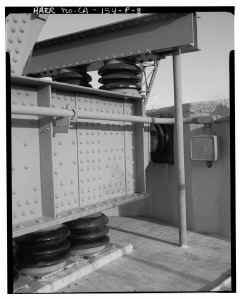
|
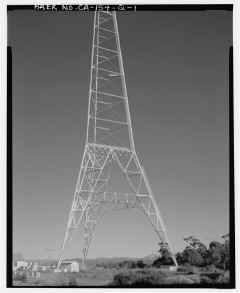
|
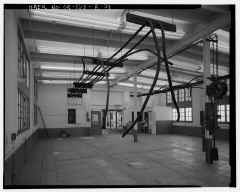
|
-- |
Chollas Heights Naval Radio Transmitting Facility was a component of the U.S. Naval Communication Station San Diego. Elements of what was the Naval Communication System were first established in the San Diego area in 1906 as part of the Eleventh Naval District. In that year, Marconi successfully applied his new "Wireless Telegraphy" in ship-to-shore communications in an experimental program. As a result of the program, wireless facilities were installed on ships of the fleet. A planned program to establish a chain of Wireless shore stations was initiated. In May 1906, "Navy Radio San Diego" was commissioned. The first facilities were located on Point Loma in one small frame building in which was installed a "Massie" type spark transmitter. With limited equipment and facilities, Radio San Diego handled in excess of 3,000 messages during the first year of operation (U.S. Navy Station History 1906-1958:1-4).
The mission of the U.S. Naval Communication Station San Diego was to provide facilities for fleet support communications including a secondary fleet broadcast (maintenance status), ship-to-shore, relay and point-to-point communications; to provide communication support to the Commander, Southern Sector, Western Sea Frontier, the Commandant Eleventh Naval District; the Commander, Naval Base San Diego and to other activities in the San Diego area; to accomplish special communication functions through the Naval Security Group; and to provide other services as assigned. The mission was originally to support the operating forces and elements of the shore establishment (U.S. Navy Station History 1906-1958:1-4).
In 1908, Radio San Diego participated in a series of tests conducted by Dr. Lee DeForest on board the USS Connecticut, a part of the Great White Fleet currently touring the world in a demonstration of U.S. seapower. Radio San Diego engaged in conducting experiments with ship-shore radio telephone communications which contributed to the advancement of radio broadcasting. This type of activity would take place all through the next eight decades as the on-shore facilities participated in a wide range of tests, experiments, and exercises with the ships at sea. Continuous upgrading of equipment and new technology required continual testing as the outer boundaries of the developing radio telecommunications field expanded and new applications were undertaken (U.S. Navy Station History 1906-1958:1-4).
Within the 11th Naval District, there were a variety of facilities including:
Radio Station, Point Loma, 12.5 acres with twelve buildings
Radio Station, Inglewood, 7.39 acres with six buildings
Radio Compass Station, Imperial Beach, 1.9 acres with three buildings
Radio Compass Station, Point Fermin, 3 acres with 1 building
Radio Compass Station, Point Hueneme, 68 acres with 4 buildings
Radio Compass Station. Point Arguello, 1 acre with 8 buildings
Radio Control Station, Headquarters SD, 3 rooms located in Headquarters Office Bldg.
Technical advancements, Navy Department needs, and Congressional actions, resulted in the development of new stations in the San Diego area to support Radio San Diego. On July 21, 1914, the government purchased 73.6 acres in the Chollas Heights area from Mr. Harry Flavel Carling for the purpose of establishing a transmitter station to provide a high power transmitter unit capable of handling traffic from Washington to the Pacific area. The development of the station was enthusiastically reported by local newspapers as it was a clear indication that the Navy was establishing a more substantive presence in the region.
The Navy was rapidly developing as a major component of the nation's military strength and the creation of West Coast bases promised to bring increased prosperity and activity to the San Diego region. San Diego leaders had begun attempting to interest the Navy in its fine harbor and military potential as early as 1871. As world events escalated and the power structures were altered by such events as World War I and the Russian Revolution, the Navy viewed the San Diego region with great interest (U.S. Navy Station History 1906-58:1-6).
The site chosen by the Navy for the radio transmitting station was located on a small mesa in an area known as East San Diego. A sparsely populated area of small farms, the spot seemed an ideal locale to meet the requirements needed by the station. Adequate security was essential and the space to add new facilities as the technology was sufficient. Water was provided by the 90 million gallon Chollas Reservoir with an embankment style dam. The dam and standby reservoir had been constructed in 1901 and put into active service in 1906 to assure a steady supply of water for the area if something happened to the main supply (San Diego Historical Society, Chollas Heights Vertical Files).
Regular reports in the San Diego Union kept readers aware of the events happening on the base. The technology of radio science was of great interest to many people and in 1916. The San Diego Union contained the following quote for its readers:
Three fabricated steel towers, will each be 600 feet in height, triangular in section, 150 feet in width at the base and 8 feet at the apex. The towers will be placed 1100 feet apart and will cost $90,000. The foundations of the towers, made of reinforced concrete, cost $7125. The phosphor bronze antennae wires, stretching between the tops of the huge masts will weigh more than a ton (1/1/16 7:8).
Construction took place during 1915 and 1916 with Bureau of Yards and Docks plans. The transmitting station at Chollas Heights was commissioned in 1916 and was subsequently identified as the U.S. Naval Radio Station (T), The first transmitter was a giant 200 kilowatt, Poulsen-arc transmitter, capable of being remotely keyed from the Point Loma operating site (U.S. Navy Station History 1906-1958:1-6; Government Printing Office 1921:365-371).
The transmitter was ready for testing by January 1917. The actual testing was a great occasion for local people and Navy officials and was attended by more than 150 people. Local citizens, such as Mayor Edwin Capps, members of the Chamber of Commerce, the Merchant's Association and prominent leaders of the community all attended what they knew was an important development for San Diego. Navy personnel in attendance included Lieutenant Commander Edwin H. Dodd, Superintendent of the Naval Radio Service for the Pacific Coast; Lieutenant Stanford Hooper, aide to the Chief of Naval Radio Service; Lieutenant Commander George C. Sweet, a leader in radio development, Lieutenant Ernest Swanson, Port Commander; Lieutenant John Ashley, Superintendent of the Southern California Naval Radio District; and George Hanscom, Naval Radio Engineer and supervisor of construction for the Station (San Diego Union 1/27/17 1:2; Manley and Wade 1992:15).
The first transmission of the Station's call letters to the station at Arlington, Virginia was made by Lieutenant Hooper. Following his successful transmission, Mayor Capps sent the following message:
In behalf of the citizens of San Diego I have the honor of extending to you the season's greetings and their good wishes and congratulate you upon the completion at San Diego of the world's most powerful radio station. Space has been completely annihilated and the Atlantic and Pacific seaboards are as one (San Diego Union 1/27/17 1:2).
Josephus Daniels, Secretary of the Navy, conveyed official Navy congratulations with a brief message:
Your greetings and congratulations much appreciated. The Navy Department rejoices with San Diego that the completion of the new radio station at San Diego places Washington in closer touch with the Pacific coast and particularly with the Navy's larger development at San Diego. It must be gratifying to know that the apparatus is the product of a California company [Federal Telegraph] (San Diego Union 1/27/17 1:2).
The complex created at Chollas Heights consisted of a number of components necessary for radio transmission and support services. The principal features of the transmitting facility at Chollas Heights were the three steel self supporting towers, Building 1 for transmitting, a modern antenna and ground system, a powerhouse and quarters for operators, all built in 1916. Over the years additional support buildings were constructed, residence capacity expanded, and recreational facilities, including a pool (the pool was also used to cool the equipment) and tennis courts, were added for the enjoyment of Station personnel and their families (Plan Files, Construction Battalion Center, 1915-1957).
The transmitting site at Chollas Heights became an essential component of Radio San Diego, and developed continuously over the next several decades. As the technology changed, upgrades of equipment were necessary to keep pace with the rapid expansion of the industry. On June 29, 1918 a contract was let to Louis A. Geisler for construction of two double married operator's quarters, Buildings C and D, for $15,207.00. On August 21, 1918, a Contract No. 3130 was let to Walter Slater for construction of a barracks building to house fifty U.S. Marine Guards on duty at the station. Building F was to be a "wooden structure of first-class material" and cost 525,537.70 with a completion date of January 1, 1919 (U.S. Navy Station History 1906-1958:1-6; Government Printing Office 1921:365-371; 11th Naval District, Report of Activities 3915-1920).
As the radio technology changed rapidly, during fiscal year 1919-1920 new equipment was added to the system to keep pace with new developments. A 30 kw primary arc set was installed and a 5 kw secondary spark set was removed to Point Loma. On December 8, 1919 a contract was let to the Walter Slater Company for $7,500.00. The contract was to construct a concrete building to adjoin the power house. Building 2, for the housing of the large helix coil being used in connection with the superprimary arc. The old antenna system was altered in design and additions were made to it. A single wave transmitting system was installed by the Federal Telegraph Company. The only building erected in connection with the installation was a temporary sheet iron shelter to house the condenser plates (11th Naval District, Report of Activities 1920; U.S. Navy Station History 1906-1958:1-6).
Additional developments on the base at this time included construction of a roadway and grading within the Station at a cost of $2500.00. The roadway was constructed through the East Gate leading to Lemon Grove from the central group of buildings. A large area was surfaced adjacent to the Building 2, Power House, on the south. Maintenance of the towers has always been an ongoing concern and by November 19, 1919, a contract was let to the firm of Kootz and Banks for painting the towers. The total cost was $8,288 which included two days overtime pay (11th Naval District. Report of Activities 1920; U.S. Navy Station History 1906-1958:1-6).
In 1924, the first electron tube type transmitter used by Radio San Diego was installed at Chollas. By this time the small station at Point Loma had been converted into a radio receiving and monitoring station under the cognizance of the Eleventh Naval District Communication Officer/Radio Material Officer. Concurrent with this, control and operational facilities were established at the District Headquarters in downtown San Diego. Received radio signals at Point Loma were connected by landline directly to operating positions at the District Headquarters, which were also connected by landline to the transmitters at Chollas Heights, thus permitting remote control of both receivers and transmitters from the District Headquarters. Service to the fleet and to shore command was expanded; Radio San Diego was to provide back up support for the primary circuits at Radio San Francisco, Material Officer, Mare Island Shipyard (U.S. Navy Station History 1906-58:1-6).
During the 1920s and early 1930s additional buildings were added to the Station. In 1930 lights were installed on the towers, in 1934 the bridge plates were renewed and in 1936 a portion of the antenna was torn out by a low-flying airplane. By 1937 there were 26 structures on the base which included eleven family quarters, one barracks building with capacity for 20 enlisted men, a power house, office, garage, shop, pump house, water tank and recreational facilities (Manley and Wade 1992:16; U.S. Navy Station History 1906-58:1-6).
Transmitting equipment changes in 1937 included an AC electrical current from San Diego Consolidated Gas & Electric Company; an 11,000 v, 60 cycle, 3 phase transmitter changed on station by the power company to a 2,300-1,100-440-22-110 v; 2,000 kva available svstem. All lines were underground and a 20 kv-a gas engine emergency unit was also installed (Manley and Wade 1992:16; U.S. Navy Station History 1906-58:1-6); 11th Naval District Report of Activities 1937.
On December 7, 1941 the transmitters at Radio Pearl were down for regular maintenance and during this period, Radio San Diego was rebroadcasting the Pearl high frequency signals, using the receivers at Radio San Francisco. The first news of the Japanese attack on the fleet at Pearl Harbor was broadcast by Radio San Diego. During the war years, continued expansion and improvements to the facilities at Radio San Diego were made to support the operating forces and the shore activities in the southern California area. The regional support played a vital role to the Pacific fleet during these war years (Manley and Wade 1992:16; U.S. Navy Station History 1906-58:1-6); 11th Naval District Report of Activities 1937.
In 1947, to provide more space for the Navy Electronic Laboratory at Point Loma, Radio San Diego (NPL) was relocated to Imperial Beach. At the same time the U.S. Naval Communication Station, Eleventh Naval District Headquarters under a Commanding Officer was established and the facilities of Radio Control and the Communication Centers located in the District Headquarters, Naval Radio Station (T) Chollas Heights and Naval Radio Station (R) Imperial Beach were combined. In 1948 the Radio Station Point Loma was officially disestablished. In 1953, the U.S. Naval Communication Station, Eleventh District was redesignated as the U.S. Naval Communication Station San Diego (U.S. Navy Station History 1906-58:1-6).
During the 1950s and 1960s, the Cold War era, communications continued to be vital and the Station played a key role in many of the telecommunications developments of the time. The U.S. Naval Communication Station San Diego and its various components participated in a wide range of Navy activities, presidential visits, naval exercises and experiments to test the capacity of new systems. Equipment designed to upgrade the power and ability of the stations to increase and enhance communications was continually updated (U.S. Navy Station History 1906-58:1-6).
In 1961 installation of a coaxial-type, RF patchboard at NAVRADSTA (T) Chollas Heights allowed improvement of the antenna flexibility for the medium and low power transmitters. Also included in this installation were six CU-729/U antenna couplers to permit the connection of Vertical Doublet antennas to the coaxial patch board (U.S. Navy Station History 1961:1-4).
In addition to normal projects and maintenance activities, NAVCOMMSTA San Diego participated in a special communication project with the USS Kitty Hawk consisting of special ship/shore communication channels to the ship for an anticipated presidential visit. A single sideband model AN/FRT-53 transmitter was temporarily installed and made operational at NRTF, Chollas Heights. The presidential visit was canceled but the USS Kitty Hawk held a naval demonstration off the coast for leading civilian and military officials to demonstrate the new technology (U.S. Navy Station History 1961:1-4).
An equipment replacement program in 1962 installed four 10 kw single side band transmitters. A D-C keying line for remote operation of transmitters allocated for the "FRA" broadcast were replaced by an audio channel between NAVCOMMSTA SFRAN (Stockton) and the Chollas Heights transmitter station. This audio channel was mutiplexed by Navy carrier telegraph equipment to provide two keying circuits. One of these circuits was allocated to the transmitters for the FRA broadcast and the other circuit to transmitters for the FR broadcast. As the year ended, the Station was providing three transmitters for the FR broadcast and four for the FRA broadcast (U.S. Navy Station History 1962:1-5).
In 1963 programmed equipment replacement resulted in considerable improvement at the transmitter station. Four AN/FRT39, one AN/FRT-40 transmitters were installed. Five 6-28 mc conical monopole antennas were constructed and installed by station forces. The streets and roads were resurfaced, and structural improvements were made to the barracks, galley and mess hall (U.S. Navy Station History 1963:1-3).
In 1964 the 30,000 gallon elevated water tank, constructed in 1915, was removed by a demolition contractor. Continued progress was made in the equipment replacement program as nine new transmitters installed. The new transmitters consisted of one AN/FRT-40, seven AN/FRT-39 and one AN/URT-19. As a result of these improvements, extensive site preparation was necessary, including grading, leveling and filling. This activity was accomplished in preparation for installation of new antennas (U.S. Navy Station History 1964:1-6).
In 1965 a new gate house was constructed by PWC SAN DIEGO at the main station entrance. Preliminary planning for a new fleet Radio Transmitting Station to replace NAVRADSTA (T) Chollas Heights was started in the latter pan of 1964 and continued into 1965. Initial consideration was given to using 800 acres at MCB Camp Pendleton for this purpose. The Commandant Marine Corps withheld approval for locating a transmitter station at any site within Camp Pendleton and additional surveys were initiated to locate a suitable place (U.S. Navy Station History 1965:1-4).
One of the main functions of the Station was to participate in the various onshore/offshore activities. New equipment was installed by INIMAN SAN DIEGO and/or Station forces during 1965. This new equipment include new transmitters and associated equipment: six AN/FRT-39, two AN/FRT-40, six Conical Monopole antennas, nine monocone antennas, seven RLPA antennas, six 10 Dielectric Patch Panels, and four overhead exhaust fans for the transmitters (U.S. Navy Station History 1965:1-4).
Continuing on into 1966, the station power improvement program resulted in a section of the secondary distribution panel being replaced, including additional new equipment. The list include one AN/FRT-72A, three AN/UGA-4, two KY-43A/URT, seven CU-1599/URT, and seven AS-1974/FRC Conical Monopole Antennas. Staffing problems during this period included a shortage of radiomen to operate the machinery. Also, a lack of electronic technicians was an additional headache for Station commanders. Many times the technology emerged first and then the technical staff had to upgrade their training so some lag time was built into the system (U.S. Navy Station History 1966:1-6).
A new Power Improvement Program for COMMCENTER and Naval Radio Station (T) Chollas Heights in 1967 was planned to double the transformer capacity and additional primary switchgear was added. To assist in the development of the project a 500 kw mobile diesel unit was temporarily installed to replace the 30 year old 170 kw unit. New equipment added at this time included: four TAB-7, three PP-4473/UG, three AN/USM-140C, one AN/USM-105A, one 1025/U, one MX-2995B/USM-117, one TS-2333A/USM, one CAQI-400H, and one CSI-4514 (U.S. Navy Station History 1967:1-4).
The Power Improvement Program continued into 1968 and provided for an additional 750 LVA transformer and additional switchgear at the Station. Added to the Station's equipment was one AN/USM-117B, one SG-582/U, four DA-484/URT, one TV-7D/U, one AN/FCC-69, one TS-2778/USM, one AN/USM-207A and three TD-908/UG (U.S. Navy Station History 1968:1-3).
In 1969 the Station participated in an activity designed to provide communications and cryptologic support for operation BREECHES BUOY (Repatriation of USS Pueblo personnel). This was typical of the types of activities carried on at the Station and continued the role played by the Station from its inception. During this same year, the Public Works Center San Diego began installation of three additional conical monopole antennas. Tests were conducted to improve harbor coverage and coverage to ships at sea beyond thirty miles for UHF RATT circuits and the tests indicated that coverage could be improved by installing UHF radio equipment in Building 1 and by using the old microwave tower at the Station for UHF antennas. The project was completed in 1970 (U.S. Navy Station History 1969:1-7).
In 1970 NAVRADSTA (T) Chollas Heights was disestablished as a separate shore activity by OPNAV NOTICE 5450 on 5 October 1970. The Station retained its departmental status and was then designated as Chollas Heights Naval Radio Transmitting Facility. The program of participating in fleet exercises, special coverages, and COMSEC surveys continued. New equipment continued to be installed to meet the needs of the fleet and included: five AS-390 UHF Antennas, two AN/URC-9 UHF Transmitters, one AN/SRC-20 UHF Transceiver, two AN/URR-35 UHF Receiver, one AN/FCC-69 Telegraph Terminal and one TS-26165/UGM TTY Test Set. Additional equipment was installed in 1971 and included two AN/FRT-74, one R-1051B/URR, and one CAQI-700A (U.S. Navy Station History 1970:1-4).
In 1972 COMNAVCOM directed that NRFT, Chollas Heights cease operations on 15 November 1972 for a period of 60 days to evaluate the West Coast HF coverage without the support of the Station. This was later extended to a period of 120 days to end on 15 March 1973. New equipment installed included two AN/FRT-74, two AN/SRC20. During the 1980s, the Station contracted with outside contractors, including Radio Corporation of America (RCA) to run the transmitting and maintenance operations on the facility.
During the 1980s, the Station continued its transmitting function and participation in fleet activities. By 1992, the decision had been made to cease the transmitting activities due to financial considerations and the more improved facilities at other locations. The towers are still fitted with aircraft warning lights which is their only remaining function at the time of the HAER documentation. The base has two operational functions at the time of the study. The AMCC Communications Van assembly takes place in Building 39 and the shop facilities function as maintenance shops.
The three triangular shaped 600-foot towers are spaced 1,100 feet apart (Figure 19). They do not conduct radiowaves themselves, but serve to support the triatic array antenna which is suspended between them. The towers arc constructed of welded and riveted structural steel and were constructed from standard plans devised by the Bureau of Yards and Docks and duplicated for the base at Arlington, Virginia; Chollas Heights, California; Pearl Harbor, Hawaii and Cavite, Philippine islands. The towers were constructed by the 12th Naval District at acost of $92,939.77. The foundations cost $7,215.00. One of the major costs to be borne in connection with the towers is painting them the distinctive red and white pattern. The original cost was under $10,000 and over the years the cost increased tenfold to over $100,000.
The three towers have one 300-foot guyed lattice mast, two 70-foot ship masts, and one 50-foot flag pole. The tower stands on a base of three legs, approximately 200 feet tall. The legs are mounted on porcelain insulators set into massive poured concrete bases. The tops of the towers hold horizontally mounted "wings" which hold the antenna wires.
The San Diego Union had the following to say about the towers during their period of construction:
Three fabricated steel towers, will each be 600 feet in height, triangular in section, 150 feet in width at the base and 8 feet at the apex. The towers will be placed 1100 feet apart and will cost $90,000. The foundations of the towers, made of reinforced concrete, cost $7125. The phosphor bronze antennae wires, stretching between the tops of the huge masts will weigh more than a ton (1/1/16 7:8).
Modifications to the towers over the years included replacement catwalks, new ladder cages, modernized lighting, repainting. In 1930 lights were installed on the towers, in 1934 the bridge plates were renewed and in 1936 a portion of the antenna was torn out by a low-flying airplane. Very few of the overall visual and engineering characteristics have changed over the years. The basic serviceable design created by the Bureau of Yards and Docks sufficed to maintain a the towers in their original form. Even though the technology changed, the purpose of the towers did not change for there was no need to change a sound, functional design.
The antennae are the heart of the transmitting station but difficult to see. A large portion of the network is nearly invisible under normal circumstances. Antennae system transmission line are set up on 18 ft. steel poles. The antennae structure also includes a buried "distributed ground system" consisting of a network of wires and rods. NAVCOMSTA Drawing RJ6D-2498 depicts the system. Changes were made in 1929, 1936, and 1957 and replacements were put in. The drawings are unclear as to how the system has changed.
Navy Radio Point Loma was established on 12 May 1906 in a small frame building on the military reservation on Point Loma as part of the Navy's first radio communications network system. It handled in excess of 3,000 messages during its first year of operation and, during the period 1906 to 1908 , participated in a number of projects that contributed significantly to radio broadcasting . Particularly noteworthy was the part it played in Dr. Lee DeForest's experiments in radio telephone communications from the USS Connecticut , then part of the Great White Fleet, which added a new dimension to the Navy's tactical flexibility .
On 21 July 1914, in order to increase the transmitting range of the facility, the Navy acquired 73.6 acres of land at Chollas Heights, about fifteen miles east of Point Loma, from Harry Flavel Carling. In 1916 the Navy completed a then modern high-power radio transmitting station on the new site. keyed remotely from Point Loma. The original 600 foot antenna towers are still in use. Further expansion of Navy Radio San Diego occurred in the 1920s, when the original Point Loma facility was converted to a receiver site only while the headquarters and message center functions were moved to their present location in the Naval Base Headquarters building in downtown San Diego.
During World War II Navy Radio San Diego played a vital role in wartime communications. Of particular historical note is the fact that it was by relay from the station's Chollas Heights transmitters that Washington first received word of the Pearl Harbor attack; Hawaii's main transmitters, capable of reaching Washington directly, went down temporarily during the attack.
The station continued to grow in size and capability when in 1941 the Navy acquired an additional 145 acres of land at Imperial Beach, adjacent to Fort Emory. an Army Coast Artillery Station some sixteen miles south of San Diego. In 1943 the Navy completed construction of a new receiver facility at the site and transferred that function from the original Point Loma site. Subsequently, the Navy fell heir to Fort Emory and adapted the facilities as office, maintenance, and storage space for Navy Radio San Diego. In 1947 the Secretary of the Navy established Naval Communications Station, Eleventh Naval District, as a separate activity under a commanding officer. In 1953 it completed the transformation that exists today by establishing Naval Communication Station, San Diego, as a completely separate command.
Major technological improvements continued in the sixties and seventies. In 1965 a Wullenweber-"dinosaur cage"-antenna and associated equipment and buildings were installed at the receiver site at Imperial Beach. In 1966 the station became part of a world-wide Automatic Digital Network (AUTODIN) of computers capable of secure, virtually error-free (i.e., sailor proof) message transmission at extremely high speeds. In the mid-seventies, NAVCOMSTA, San Diego, installed its first Local Digital Message Exchange (LDMX), updated its computers, and replaced obsolete copiers. Toward the end of the decade it installed the Message Reproduction and Distribution System (MRDS), which completed the automated loop and produced a communications system that is capable of providing almost "hands-off" message service to subscribers in the area, In 1980 the Remote Information Exchange Terminal (RIXT), which provided the latest state of the art in optical scanning, video display control, automatic logging, and high speed transmission and reception became operational.
Today NAVCOMSTA, San Diego, is providing rapid, secure, and reliable communication service to the fleet, and the Navy intends to keep it that way by remaining abreast of developments in technology and making additional changes to meet the overall naval communications goal of reducing manpower-intensive operations and further improving service.
BIBLIOGRAPHY
A. "Command History, Naval Communications Station, San Diego, 1906," and supplements (Washington: Naval Historical Center, Operational Archives Branch).